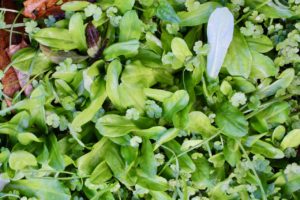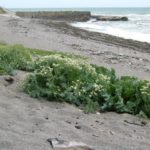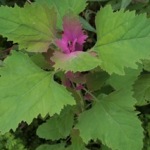Cudweed – Gamochaeta coarctata (formaly Gamochaetata spicata)
I’ve seen and known about Cudweed in my foraging for some time, but this is the first time I’ve ever written about it. Cudweed’s unusual feature is the dual colour of the leaves which are bright green and smooth on the upper surface and white underneath. The white being densely matted hairs looking like a piece of felted material when seen up close. Hence Cudweeds’ Greek name Gamochaeta means joined
bristles and the former name spicata is latin for spike, or ear of grain. This refers to the flower spike the plant sends up 15-20cm from the rosette of leaves. There are many tight clusters of small, whitish flowers which look rather dull and inconspicuous compared to bright, bold dandelions and sunflowers who also belong in the Asteraceae family of plants. The leaves don’t have stalks, they radiate straight out from the centre of the rosette and die off by the time the flower stalks grow up. There are leaves up the stems which get smaller and thinner nearer the top and are absent at the very top where the flower clusters sit.
The name Cudweed becomes obvious I discovered when I plucked a leaf and chewed/tasted it between my
two top teeth and tongue. It is very fibrous and sounds crispy because it is a bit fleshy as you chew and chew, but the fibre stays in your mouth – perhaps I’ve discovered a new chewing gum! I wanted to see how long I could chew it for and while chewing I noticed I felt quite calm and relaxed. Not breaking down I finally swallowed the fibre. I wonder what others have experienced chewing this plant? You may not have even known you could eat it. Cudweed is not bitter, nor hairy and is actually quite pleasant with its mild flavour providing a new option to add to salads, soups, pesto and smoothies.
Cudweed is native to South America and is common all over the North Island of NZ and parts of the South Island. It grows on the edge of forests or wet stony sites, lawns, pasture, river beds, cultivated crops and coastal places, so it is a pretty hardy character able to handle a variety of conditions.
There are several other introduced species growing in similar habitats:
Gamochaeta purpurea has leaves woolly-hairy on both surfaces, found scattered in the NI
Gamochaeta implicicaulis has thick stems and leaves amongst the flowers. Found North from the Waikato and Bay of Plenty.
Gamochaeta calviceps or silky cudweed is branched and spread on the ground as well as branches on the stem. Leaves are long and thin. Common throughout NZ.
Gamochaeta subfalcata another silky cudweed, fewer branches, less spreading, bright reddish-purple flowers found in Northland, Auckland, Coromandel and Wellington.
Euchiton sphaericus Japanese Cudweed or Globe cottonwood this is a native species of Cudweed found all
over NZ in where the rainfall is below 1000mm. This Cudweed is different to the others with an elegant pompom shaped flower head being reddish purple or pale brown in colour, and four leaves immediately below it. Photo right.
Cudweed is in its leafy stage during winter, so picking a few leaves can add variety to your salad and smoothie bringing more diversity to your diet. I’m pleased there is yet another ‘weed’ that grows in our lawn, gardens and pasture that we can eat! Below you see Cudweed growing in amongst Waxweed or native Hydrocotyl heteromeria a creeping mat-forming perennial often found in lawns, forest margins and clearings.
Patch of Cudweed amongst Hydrocotyl heteromeria









Wonderful info..thank you
Hi Lyn thank you so much for taking the time to write a little note. I really appreciate it!! So glad you found the information useful!